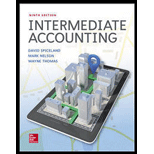
Concept explainers
Derivatives: Derivatives are some financial instruments which are meant for managing risk and safeguard the risk created by other financial instruments. These financial instruments derive the values from the future value of underlying security or index. Some examples of derivatives are forward contracts, interest rate swaps, futures, and options.
Interest rate swap: This is a type of derivative used by two parties under a contract to exchange the consequences (net cash difference between interest payments) of fixed interest rate for floating interest rate, or vice versa, without exchanging the principal or notional amounts.
To determine: The effect of gain or loss on the notional difference of $500,000, the difference between fixed rate debt of $2,000,000, and the $2,500,000 interest rate swap
Want to see the full answer?
Check out a sample textbook solution
Chapter A Solutions
INTERMEDIATE ACCOUNTING (LL) W/CONNECT
 Intermediate Financial Management (MindTap Course...FinanceISBN:9781337395083Author:Eugene F. Brigham, Phillip R. DavesPublisher:Cengage Learning
Intermediate Financial Management (MindTap Course...FinanceISBN:9781337395083Author:Eugene F. Brigham, Phillip R. DavesPublisher:Cengage Learning Fundamentals of Financial Management, Concise Edi...FinanceISBN:9781285065137Author:Eugene F. Brigham, Joel F. HoustonPublisher:Cengage Learning
Fundamentals of Financial Management, Concise Edi...FinanceISBN:9781285065137Author:Eugene F. Brigham, Joel F. HoustonPublisher:Cengage Learning Fundamentals of Financial Management, Concise Edi...FinanceISBN:9781305635937Author:Eugene F. Brigham, Joel F. HoustonPublisher:Cengage Learning
Fundamentals of Financial Management, Concise Edi...FinanceISBN:9781305635937Author:Eugene F. Brigham, Joel F. HoustonPublisher:Cengage Learning


